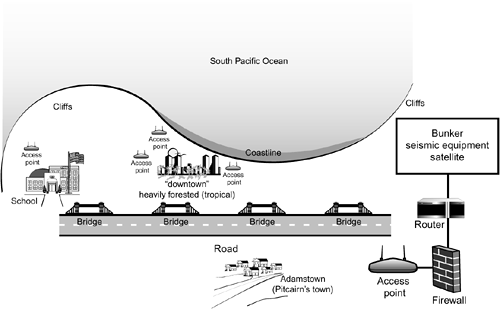| Understanding networking concepts can help to resolve real-world problems with setting up Wi-Fi networks. Here's an example that shows how some advanced networking concepts were used to set up a Wi-Fi network on Pitcairn Island. Pitcairn Island is a remote, rugged speck of land in the south Pacific Ocean, thousands of miles from anywhere. Pitcairn was the last refuge of the mutineers from the HMS Bounty, which was seized from the infamous Captain Bligh in 1789. Following the seizure, the mutineers, led by Fletcher Christian, fled to Tahiti, where several were eventually captured by the British navy and brought home for trial and execution. Christian and some other mutineers, along with Tahitian companions, fled in the Bounty to Pitcairn, where they eventually burnt the Bounty to avoid detection by the British navy. Today, almost 50 people live on Pitcairn, which is administered from New Zealand. Most of these 50 people have computers. Thanks to the Albuquerque Seismological Laboratory and the USGS (United States Geologic Survey), Pitcairn Island also has Internet access. It seems that Pitcairn is located near an area of intense earthquake activity, and the USGS needs to keep seismologic monitoring equipment on the island. The USGS is kept connected to its seismic equipment via an Internet connection provided by satellite provider Inmarsat (www.inmarsat.org). Some of the extra bandwidth on this rather expensive connection is used by the Pitcairn Island residents. A team including Chris Hopper and Bill Haigh used Wi-Fi to extend the Internet access from the concrete bunker containing the seismic equipment and Inmarsat link to the Pitcairn Island residents using off-the-shelf components. This involved many challenges due to the ruggedness of the terrain, the tropical climate, and the remoteness of Pitcairn itself, but I'd like to highlight two issues here. First, the distance along the road from the access point connected to the satellite to the school (the farthest point that needed access) was about a kilometer (a thousand meters). It would have been ideal to use a fixed wired backbone along the road from the bunker to the school, creating a kind of tree topology. But the problem with this was that the standard Ethernet wire that was available has a maximum range of 100 meters. So the distance was covered by adding wireless access points configured as bridges along the line-of-sight road to cover substantial portions of it, connecting the bridges with hundred-meter lengths, and then jumping via wireless to the next bridge, and so on, covering the required distance.  | If fiber optic cable had been available, laying down a backbone of the length required would not be an issue. The 100-meter limitation is a limitation of standard 10BASE-T Ethernet cable. |
Figure 15.16 gives a rough idea of the physical topology of the Pitcairn installation. Figure 15.16. The problems in creating a network topology for Pitcairn Island's Wi-Fi network included a backbone distance too long for standard Ethernet cable, and a dense foliage area. 
If you look at the "downtown" area shown in Figure 15.19 (the "town" in "downtown" being Adamstown, the only town on Pitcairn Island), you'll see that I've marked it as heavily forested. In fact, the vegetation is tropical foliage, dense with water. The problem with this is that water almost completely absorbs Wi-Fi broadcasts on the 2.4GHz spectrum. (This is the physics-based reason that microwaves use the 2.4GHz spectrum: The microwave signals are used to stir the molecules in food items, most of which are very high in water content.) As a practical matter, this meant that quite a few access points needed to be positioned in the dense foliage area (more access points were needed because the tropical foliage absorbed the signals). Each access point connected to the wireless bridges along the "backbone" running along the road. In addition, each access point was equipped with an external antenna to better amplify its signals. (For more on antennas and other signal boosters, see Chapter 17, "Adding Wi-Fi Antennas to Your Network.") The Absolute Minimum Here are the key points to remember from this chapter: It's easy to create ad-hoc Wi-Fi connections between Wi-Fi equipped computers. Ipconfig can help you resolve Internet configuration issues with your computers on your network. Simple star-topology access point networks are easy to set up and manage, but when your networks start getting complicated, there are many things to think about.
|
| 